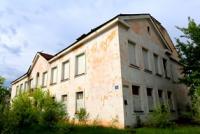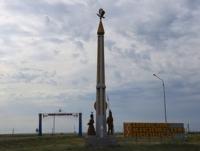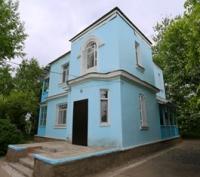You are here
Kurchatov town.




Sights of towny Kurchatov
"There is no East,
And there is no West.
There is no end to the sky.
No east
And there is no West
Father has two sons.
No east
And there is no Westthere is
Sunrise and sunset
There is a big word -
LAND!"
Visiting to town Kurchatov.
The city of Kurchatov - the center of the former Semipalatinsk test site is located at an altitude of 163 meters above sea level, is located 145 kilometers north-west of the city of Semipalatinsk, 239 kilometers southeast of the city of Pavlodar, on the right bank of the Irtysh River, in the Beskaragai region of the East Kazakhstan region.
The town of Kurchatov is the center of the former Semipalatinsk test site. It is located in the north-west of the East Kazakhstan region. It covers an area of 11 thousand hectares. The city of Kurchatov includes the town of Kurchatov itself, the railway station Degelen (2 km) and the village of Moldary (3 - 4 km).
These settlements are not independent and are not listed in the reporting. The climate of Kurchatov is sharply continental. It is characterized by: aridness of the spring-summer period, insufficient and unstable amount of precipitation during the years and periods of the year, significant wind activity throughout the year, and especially in the spring, high summer and low winter air temperatures.
The average annual rainfall is up to 250 mm, while only about 90 mm fall in the period of intensive vegetation (May-July). The height of the snow cover is small, average for winter, in open areas, is about 13 cm. The average annual air temperature is positive and amounts to + 2.4 degrees.
The maximum temperature in some years can reach + 40 - 42 degrees, the minimum can reach - 48, - 49. The warmest month is July, the coldest are January and February. The prevailing winds are winds of the south-west and west directions, their greatest intensity falls on April, May, June.
The city is located on the left bank of the Irtysh River in a dry agroclimatic zone with a state customs control equal to 0.3 - 0.5 (a subzone of desert wormwood and feather grass steppes). In Kurchatov, scientific and research laboratories, centers of physicians and biologists, mathematicians and physicists were concentrated, as well as production bases of mine builders, drillers, prospectors, builders.
It was a cozy town, carefully planted with trees, with fountains, parks and playgrounds, an airfield, railway and bus stations, as well as the Palace of Culture, a museum, its own television and newspaper. Concrete and asphalt roads stretched to the steppes for tens and hundreds of kilometers to the sites where nuclear explosions boomed.
All day long, mirrors of radar installations and radio antennas were streaming into the sky, which kept watch day and night to protect and maintain communication with the center and test sites of the test site. It was a closed prosperous city of the Military Industrial Complex (MIC).
There were all conditions for research and experimental work. Famous Soviet physicists I. Kurchatov, Yu. Khariton, A. Sakharov, Ya. Zel'dovich lived and worked in the city. They are considered the fathers of nuclear weapons.
Since 1947, it received the status of a city and became known as Kurchatov. Known in the world as Semipalatinsk - 21 (post office). The history of the city is inextricably linked with the history of the creation of a nuclear weapons test base.
The most difficult defense tasks in the country that survived the most brutal Great Patriotic War in its history were dealt with, created in 1947 by a resolution of the Council of Ministers. USSR and Central Committee of the CPSU, Mountain Seismic Station (GSS), “Object 905” for field tests of atomic charges.
The first commander of UP-2 was Pyotr Mikhailovich Rozhanovich, artillery lieutenant general (February - September 1948). He was replaced by Major General of Artillery Kolesnikov Sergey Georgievich. The last commander of the Semipalatinsk test site was Major General Yury Vladimirovich Konovalenko.
The scientific leadership in the preparation of the first tests was carried out by Igor V. Kurchatov. Military builders were the first to land in 1947 on the banks of the Irtysh River (the largest tributary of the Ob, one of the most important rivers of Kazakhstan).
145 km from the city of Semipalatinsk, downstream of the Irtysh, construction and installation work began on the construction of housing, administrative buildings and technical structures. It was hard to start construction from scratch.
They built a tent camp for personnel and a bathhouse, for which hot water was prepared on the street in iron barrels, on the banks of the canal. At the same time, they dug pits for dugouts, harvested rods and weaved fascines, and with the arrival of the forest and the installation of rack frames, they closed the dugouts for soldiers with fascines and covered them with earth.
Officer's dugouts were covered with boards and sheathed with plywood from the inside. In 1990, the town's population was more than 20,000 people. Kurchatov was the main laboratory and experimental base of testers. The housing stock of the city was 176056 sq. M, of which 69500 for military personnel.
In the city there was an airfield with a dirt landing strip, a dairy factory for 10 tons, a bread factory for 143 tons of products per day, 8 preschool institutions for 1150 children, 3 schools for 3000 places, a military hospital with 50 beds, a medical unit, a sewing branch Bolshevichka factories, a number of small enterprises and cooperatives.
The release of radioactive gases to the surface after the test on February 12, 1989 was the impetus for the formation of a powerful antinuclear movement "Nevada - Semipalatinsk." After the publication of the Decree of the President of the Republic of Kazakhstan N. Nazarbayev dated 29. 08.1991, No. 409 on the closure of the Semipalatinsk test site, the situation in the city was not a simple situation.
The rapid curtailment and redeployment of the Russian military units from the training ground created a real danger of the complete destruction of the entire scientific and industrial structure and social sphere of the town.
The decision of the country's leadership on the organization of the National Nuclear Center of the Republic of Kazakhstan on the basis of the complex of the former Semipalatinsk test site and relevant scientific organizations and facilities located on the territory of Kazakhstan, allowed to maintain the scientific potential.
Continue operation and ensure the safety of nuclear research reactors, begin full-scale implementation of the Republican targeted scientific and technical program for radioecological research and rehabilitation of the territory of the former Semipalatinsk test site.
After the closing of the Semipalatinsk test site in 1991, Kurchatov from a town with developed infrastructure turned into an urban-type settlement. The first efforts to restore Kurchatov were made in 1995, when half a billion tenge was allocated from the state budget for urgent needs.
The restoration of the city is still ongoing. Now 9.5 thousand people live in the town. Kurchatov’s area is 11 thousand hectares. The National Nuclear Center (NNC) and its research institutes formed in 1992 on the basis of a potential scientific training ground operate here.
The activities of NNC RK allowed attracting significant foreign investments, creating hundreds of additional jobs in the town. In order to convert the scientific and technical potential for the development of the landfill and the use of new technologies, in 1995 a joint Kazakh-American enterprise "CEMTECH" was created.
In 1996 - KK Interconnect, whose main profile is the production of printed circuit boards and electronic devices. Geological exploration is carried out by the joint Kazakh-American enterprise FML Kazakhstan. The SIP territory is characterized by a remarkable concentration of promising deposits, primarily gold and copper, and also has significant reserves of non-metallic raw materials.
On the territory of the city, the Degelen enterprise is engaged in the extraction and processing of natural stone "gabbro". Today NNC RK is a city-forming organization in the city of Kurchatov. There is also a museum in Kurchatov, which contains samples of nuclear-testing equipment, fragments of atomic bombs, and materials that have preserved traces of the effects of explosions.
Here are photos of scientists and public figures who were associated with the work carried out at the training ground and with its closure. Since 1996, the joint Kazakh-American enterprise KK Interconnect has been operating in the city, created by NNC RK, the KRAS Corporation (USA, Pennsylvania) and the US Defense Enterprises Fund under the Intergovernmental Agreement between the Republic of Kazakhstan and the USA.
The enterprise is engaged in the production of household electronic products, computers, computer components, telecommunications equipment, printed circuit boards, etc. The Degelen enterprise is engaged in the extraction and processing of natural stone.
In addition, the city has a hospital, two schools, a cultural center and a private hotel-type hostel. Thus, despite the trials that fell to the lot of the city of Kurchatov, he continues to live. On the basis of the Semipalatinsk test site, by decree of the President of Kazakhstan Nursultan Nazarbayev, the National Nuclear Center of the Republic of Kazakhstan (NNC RK) was established in 1991 with many of its subsidiaries: Institute of Geological Research (ISI), Institute of Nuclear Physics (INP), Institute of Atomic Energy (IAE) and many other organizations working for the peaceful atom and the cooperation of science and business.
The company has become a city-forming. Today, the Nuclear Technology Park is being built in Kurchatov (created by decree of the President of the Republic of Kazakhstan, Nursultan Nazarbayev, April 4, 2003), which will establish the production of high-tech products using peaceful atom. It includes:
Office building
Complex of radiation technologies
Radiation sterilization housing,
Transport and logistics center,
Nuclear Energy Technology Complex and social facilities.
According to the plan, in 2010 the implementation of projects for the production of explosives (Ammonit LLP) and the production of radiation-cross-linked connecting sleeves for rolling stock (Dempurg-PNT LLP) will begin.
People were drawn into the city. The population of the city is growing every month. There is an influx of personnel into the nuclear industry. The military contingent is growing, the purpose of which is the protection of strategic facilities and nuclear industry enterprises.
In 2010, it was planned to begin construction of a nuclear power plant in Kurchatov using Japanese technology based on a fourth-generation reactor with a capacity of 600 to 1000 MW. Today, the experimental field is protected, since it is necessary to control the dangerous territory and the flows of radioactive metal. Lakes located in huge craters from nuclear explosions are also dangerous.
Their shores are radioactive. Also under the protection are adits of the Degelen massif, where they conducted underground nuclear tests. A total of 465 nuclear weapons tests were conducted at SINP. Nuclear weapons test sites today attract tourists from various countries: the USA, Japan, Germany, France, China, South Korea, Russia and many others. Hundreds of people annually visit the experimental field of ground and air tests, on which to this day huge concrete structures, where video equipment was located, have been preserved; bomb shelters, various infrastructure facilities; and at the site of the underground tests (Degelen mountain range), international groups of scientists are exploring the cavities of underground explosions.
The landfill is turning into the "Big World Laboratory for Radiation Research." In 2010, the Kazakhstani fusion Tokamak reactor (KTM) was commissioned.
Geographic coordinates of the city of Kurchatov: N50 ° 45'59.58 "E78 ° 31'41.51"
Authority:
Balmukhanov S. Nuclear test site with my eyes / S. Balmukhanov // Prostor. - 1990.- No. 11.- P.155-174. Boztaev K. Semipalatinsk training ground / K. Boztaev. - Alma-Ata: Kazakhstan, 1992.-192 p. Demidov V. City, which was not / V. Demidov // Arguments and Facts.-2003. - No. 43.- (Gas. To gas. “AIF. Kazakhstan.” - C.5). http://kurchatov.vko.gov.kz/ru/city6.htm
Photos by
Alexander Petrov.







